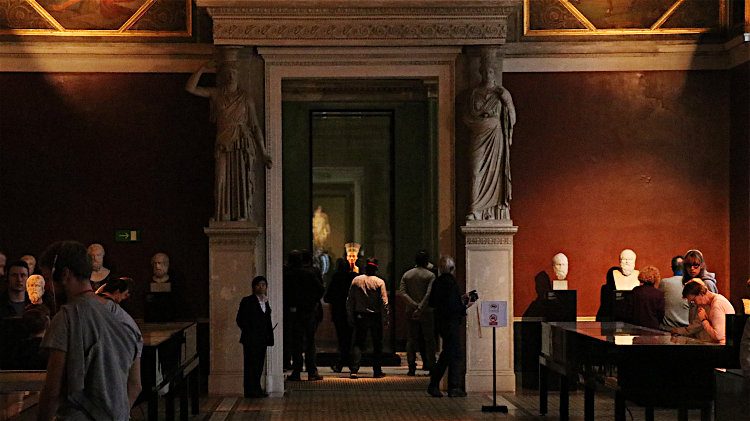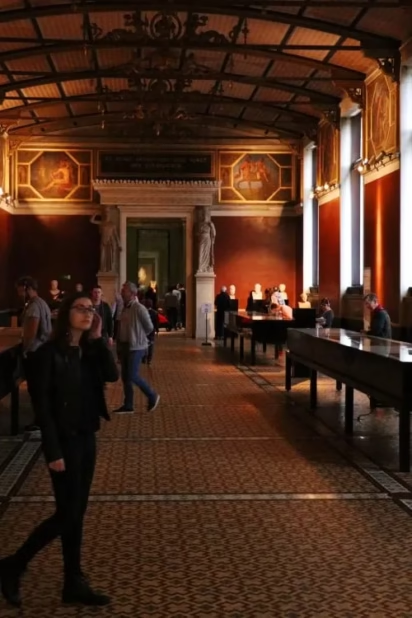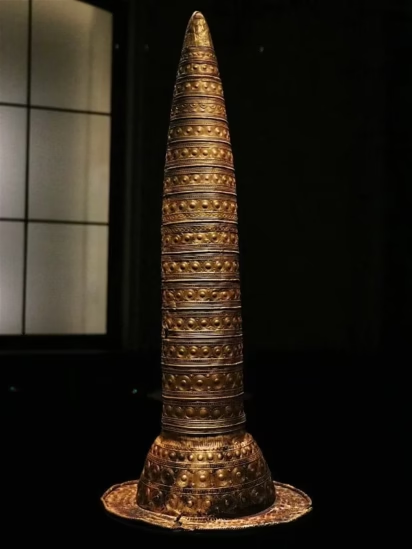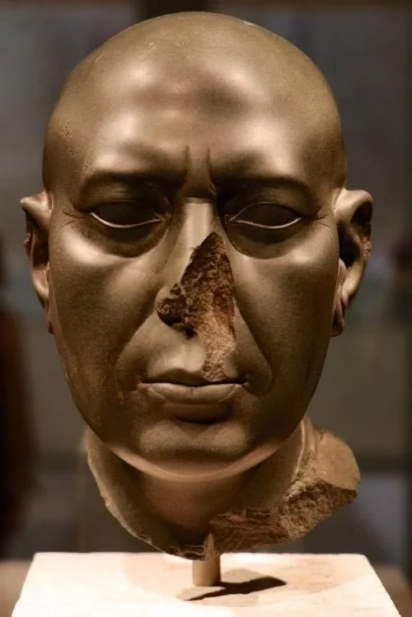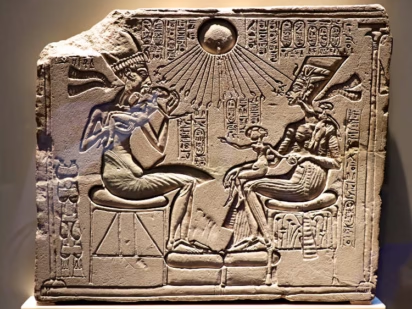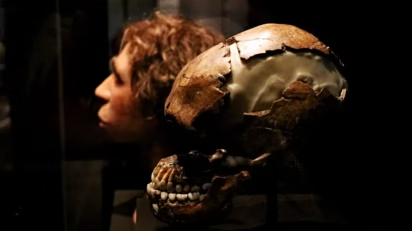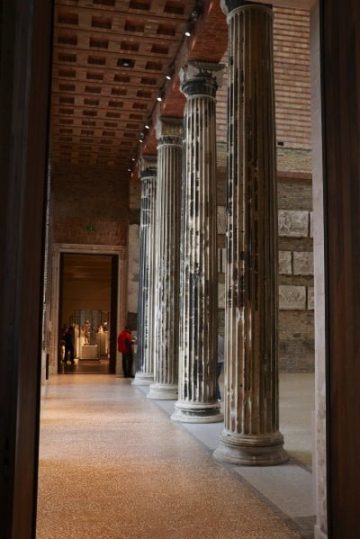The bust of Queen Nefertiti (Nofretete) is the top attraction of the Egyptian Collection in the Neues Museum on Museum Island in Berlin.
The Neues Museum is one of the most popular museums to visit in Berlin. Its top must-see item is the bust of Queen Nefertiti (Nofretete in German) –- one of the most famous artworks from Ancient Egypt. In addition to the Egyptian Museum and Papyrus Collection, the Neues Museum is also home to the Museum for Prehistory and Early History. Top attractions from these collections include the Celtic Golden Hat calendar, a Neanderthal skull, and items from Heinrich Schliemann’s excavation of Homer’s Troy. Buy tickets online with timeslot admissions or make free time reservations when using discount combination savings tickets.
Shorter Berlin Museum Opening Hours in 2025
Since mid-April 2024, several top museums in Berlin are closed on both Monday and Tuesday with shorter opening hours on many days. See the latest Berlin museum opening hours for details.
Currently, time-slot reservations are obligatory only for the Neues Museum, but sensible if available for the Alte Nationalgalerie, Gemäldegalerie, Neue Nationalgalerie, Neues Museum, and Das Panorama. (The Pergamon Museum itself is closed until 2027!) Timeslots are released only a few weeks in advance. Buy tickets and make reservations online at GetYourGuide or at SMB.
Online tickets for museums without timeslot reservations are skip-the-line — go directly to the entrance to scan the ticket. Many multiple-museum tickets and passes are again accepted, including Kulturforum, Museumsinsel, and the excellent value 3-day Berlin Museum Pass.
The Neues Museum on Museumsinsel Berlin
The Neues Museum on Museum Island in Berlin is one of the top museums in Germany and with the bust of Nefertiti for many the main reason to visit. She made the museum so popular that time-slot tickets are required to visit the Neues Museum.
Neues Museum means New Museum. The name simply confirms that the museum building was built after the adjacent Altes Museum. The Neues Museum was originally finished in 1855 but heavily damaged during the Second World War. War damage mostly left the building unused until the late 20th century. A full restoration that purposely left much of the war damage still visible was only completed in 2009.
Somewhat ironically, the Neues Museum has the oldest items on display from the following collections of the Berlin State Museums:
- The Egyptian Museum and Papyrus Collection (Ägyptischen Museum und Papyrussammlung) includes items from ancient Egypt and Nubian cultures spanning four millennia. “Die Nofretete” is of course the main attraction.
- Museum for Prehistory and Early History (Museum für Vor- und Frühgeschichte) covers six millennia of archaeological finds mostly in Europe and the Near East from the Stone Age to the Middle Ages.
- A few items from the Classical Antiquities Collection (Antikensammlung) are displayed but most of this collection is in the Altes and Pergamon Museum.
The top six must-see attractions of the Neues Museum are:
- The Bust of Queen Nefertiti – one of the most famous artworks from Ancient Egypt.
- Thirty Centuries of Sculpture – a collection of Egyptian heads showing how art changed over three millennia.
- The Golden Hat – a Celtic calendar in the form of a ceremonial hat from around 1000 BC.
- The Stone Age Collection – including a Neanderthal skull and the skeleton of an elk found locally.
- Treasure from the Rhine – Roman art found in the Rhine River including the Xantener Knabe statue.
- Schliemann’s Troy – mostly copies of the treasures Schliemann brought back from Homer’s Troy.
TIP: The Neues Museum is too big to see everything in a single visit. Furthermore, it covers a fairly wide spectrum of themes making it sensible to focus on specific areas or top sights on a first visit. Many visitors only go to see Nofretete leaving many of the other halls pleasantly quiet.
The Egyptian Museum and Papyrus Collection in Berlin
The Egyptian Museum and Papyrus Collection is spread over three floors of the Neues Museum in Berlin:
The bust of Nefertiti is on the second level, as are a variety of other sculptures from Ancient Egypt and the large papyrus collection. The papyri are displayed in glass cabinets in a darkened room with different items sliding out on demand.
On the ground floor is the Dreißig Jahrhunderte (30 Centuries) collection of head sculptures (Room 109) that shows how art and the depiction of people developed in ancient Egypt over a period of 3,000 years. These heads included not only pharaohs and priests but also other less important figures. The best-known statue – the Berlin Green Head – is of an unknown person made around 350 BC.
In the cellar are further small displays covering death and life after death. The number of mummies on display is surprisingly small for an Egyptian museum with the animal mummies probably the more interesting.
The Bust of Queen Nefertiti in Berlin
The bust of Nefertiti (Die Büste der Nofretete) in Room 210 is the undisputed highlight of the Neues Museum and one of the most famous single items of Egyptian art in the world. It dates from the period around 1351 – 1334 BC and came to Germany shortly before the First World War.
Born a commoner, Nefertiti married pharaoh Akhenaton (Echnaton), and thanks to this statue is after Cleopatra the most famous Egyptian queen ever. Slightly irritating to many Egyptologists, this statue is not particularly representative of Egypt or the period. Other depictions of Nefertiti and the royal family on display in the museum are more typical (but less popular).
The Bust of Nefertiti is nearly half a meter tall and made of sandstone with painted stucco layers. The overall condition of the sculpture and the paint color are remarkably good and show amazing details including wrinkles around the eyes.
Photography is not allowed in the room where Die Nofretete is on display. As a result, the crowds move on fairly fast making it easy to study the statue close up in more detail and fully appreciate its timeless beauty.
[Somewhat surprisingly, one of the best Ancient Egyptian collections in Germany is not in a major city. The Roemer-Pelizaeus Museum has one of the four best collections in the world on the Old Kingdom. It is in the small city of Hildesheim (near Hannover) and is more famous for its UNESCO-listed Romanesque churches and large half-timbered buildings.]
The Museum of Prehistory and Early History in Berlin
The largest part of the Neues Museum in Berlin is used by the Museum of Prehistory and Early History. Unfortunately, many items are copies, as around 10,000 items confiscated after the Second World War are still on display, or in storage, in various museums in Russia. However, the copies (Nachbildungen) mostly made before the Second World War are good and enough original items are on display to make for a very interesting visit.
The Stone Ages in the Neues Museum
The Stone Age (Steinzeit) collection is on the top floor of the museum. The displays include the usual collection of archaeological finds and bones with the following two items of particular interest:
- The largely intact skull with a full set of teeth of an 11-year-old male Neanderthal (Homo mousteriensis Hauseri) was discovered in Le Moustier in France. It dates from around 45,000 BC. Modern scientific technology made it possible to make a bust of what the boy probably looked like.
- The Elch vom Hansaplatz — the full skeleton of a moose from around 10,700 BC was discovered in Berlin in 1956 during the construction of the local U Bahn.
The Golden Hat and the Bronze Age in the Neues Museum
The Golden Hat (Berliner Goldhut) in room 305 is one of the highlights of the Neues Museum and the Staatliche Museen zu Berlin collections.
This 74-cm high ceremonial hat from southern Germany was hammered without a seam from a single piece of gold leaf during the late Bronze Age (1000 – 800 BC).
The Golden Hat is not only pretty to look at but had a practical use as a very advanced calendar.
It is displayed in its own room with detailed explanations of how the celestial symbols on 21 horizontal bands may be used to determine the calendar through either the 365-day sun year or the 12 lunar cycles of 354 days. The calculations allowed for leap years too.
A similar golden hat is on display in the Germanisches Nationalmuseum in Nuremberg.
In the adjacent room, press the button to hear the lurs playing. (Only copies are on display, the originals are still in Russia.)
Treasures from the Rhine in the Neues Museum
The second level of the museum has several exhibitions on the Romans and especially the Roman provinces that included the southern and western parts of modern-day Germany.
Larger exhibitions of the Antiquities Collection are in the Pergamon and Altes Museum.
A highlight here is the Treasures from the Rhine (Schätze aus dem Rhein) – a large collection of Roman items that were presumably sunk in the Rhine by “barbarians” in the third century. Most items are typical items used in Roman private houses.
A top attraction is the Xantener Knabe (Boy of Xanten) – a largely intact life-size bronze sculpture from the first century AD that was also recovered from the Rhine.
Schliemann’s Troy in the Neues Museum
Heinrich Schliemann (1822-1890) was one of the most famous German amateur archaeologists ever and famously excavated Troy with more enthusiasm than scientific methods or patience. Although later archaeologists accused him of wanton destruction of much of historic Troy, he did bring some fantastic treasures back to Germany and sparked much interest in archaeology in general.
Schliemann’s Troy used to be one of the top attractions of Berlin’s historical collection, but most items were transported to the Soviet Union in 1945 and never returned. Good copies, and a few original items, are on display in a small exhibition on the ground floor of the Neues Museum.
Neues Museum Berlin Visitors Information
Buying Tickets for the Neues Museum in Berlin
Admission tickets for the Neues Museum are €14 and free for children up to 18 years old. An excellent free audio guide is included. Buy Neues Museum tickets online and go directly to the entrance.
Alternatively, buy tickets in the new Simon James Gallery, which is the new main entrance to the Neues Museum (and Pergamonmuseum, once it reopens).
When buying tickets for the Neues Museum only, a timeslot for admission should be specified. When buying any of the discount offers below, make free online reservations at the Neues Museum website.
With time slot admission codes, skip the waiting line outside the museum by showing the ticket at the door. Pick up a free audio guide and then have the code on a phone (or paper printout) scanned directly at the entrance to the collection without passing by the ticket counter.
A variety of combination discount savings tickets for the Neues Museum are available:
- €24,00 – Museum Island Ticket: admission to all SMB museums on Museum Island for a day (now also available online).
- €32 – Museum Pass Berlin: unlimited admission to over 30 top museums in Berlin on three consecutive days including the Neues Museum and all Museum Island museums.
- €54 – Berlin Welcome Card 72h + Museum Island: gives all the transportation and savings advantages of the regular Welcome Card plus free admission to the Museum Island museums. (Note: the regular Berlin Welcome Card does not give admission or any discounts for the Neues, Pergamon, or any other of the Berlin State Museums.) Buy from Get Your Guide online (but a paper printout must usually be exchanged for a ticket at an information office.).
- €25 to €120 – Annual Membership Passes: admission for a year to all 19 Staatliche Museen zu Berlin museums.
TIP: None of these savings passes, except the €120 annual membership pass, are skip-the-line tickets – make free time-slot reservations online for the Pergamon and Neues Museums.
Opening Hours for the Neues Museum in Berlin
The Neues Museum is open Tuesday to Sunday from 10:00 to 18:00. (From mid-April 2024, the Neues Museum is no longer open Thursday evenings.)
In summer 2024, the Neues Museum will only close at 20:00 on Tuesday to Saturday from 4 July to 1 September 2024.
The Neues Museum is open on most vacation days but not on December 24 and usually shorter hours on December 31 and January 1.
TIP: Free time-slot reservations are very sensible to avoid queuing outside the museum. The museum is generally busiest in the mornings and all day on weekends.
Transportation to the Neues Museum
The Neues Museum, Bodestraße 1-3, 10178 Berlin, is on Museum Island in Mitte in the heart of Berlin.
Admission is currently possible either at ground level or via the basement and the modern James-Simon-Galerie that is often used for temporary exhibitions.
The most convenient U-Bahn stop is U-5 Unter den Linden or use bus stop Lustgarten for buses 100 or 300.
More on the Berlin State Museums (Staatliche Museen zu Berlin):
Note new opening times for many Berlin museums in 2025 — several are now closed on both Monday and Tuesday.
Timeslot reservations are sensible (and sometimes needed in busy periods) for the Alte Nationalgalerie, Gemäldegalerie, Neue Nationalgalerie, Neues Museum, and Pergamon – Das Panorama. (The Pergamon Museum itself is closed until 2027!). Timeslots are released only a few weeks in advance. Online tickets are available from GetYourGuide or SMB.
Many passes and multi-museum tickets offer savings (Kulturforum / Museums Island). Individual museum ticket prices range from €8 to €14 (€20 for special exhibitions). Online tickets are skip-the-line — go directly to the gallery entrance to scan the code.
For more general information on the Berlin State Museums:
- Top National Museums and Galleries in Berlin (brief overview)
- Berlin State Museums: What Is Seen Where? (a short description of the collections in the different museums)
- Opening Hours of Berlin State Museums (2025) — major changes since mid-April 2024!
- Ticket Prices for Berlin State Museums (prices for museums, temporary exhibitions, combination tickets, online time-slot reservations). Buying online from GetYourGuide is easy. A ticket with a QR or bar code is scanned directly at the entrance — no need to pass by the ticket desk (but pick up the free audio guide before entering).
- Save with the Berlin Museum Pass – 30 museums (including all the SMB museums) in three days for €32 – a fantastic savings deal.
- Staatliche Museen zu Berlin (official website in German & English).
News & Temporary Exhibitions in Berlin in 2025:
- 2025: Top Special Art Exhibitions in Berlin in 2025 & Top Contemporary Art Exhibitions in the Hamburg Bahnhof.
- Museums closed in 2025: The Pergamon Museum is closed until 2027 (some sculptures are on display in Das Panorama), the Museum Berggruen is closed until 2026 (much of its collection is traveling the world), the permanent collection of the German History Museum (Zeughaus) is closed but temporary exhibitions continue in the Pei Building.
More Museum Reviews and Museum-Specific Information:
- Alte Nationalgalerie — 19th-century art.
- Altes Museum — Greek, Etruscan, and Roman art.
- Bode Museum — sculptures from the Middle Ages, Gothic, Renaissance, Baroque, and Classical periods, Byzantine Art, and coins.
- Ethnological and Asian Art Museums in the Humboldtforum.
- Friedrichswerdersche Kirche (free admission) with a collection of 19th-century German sculptures.
- Gemäldegalerie — German and Dutch Old Masters and Italian paintings.
- Kunstgewerbemuseum (Decorative Arts).
- Musical Instruments Museum near the Berliner Philharmonie.
- Neue Nationalgalerie — 20th-century art.
- Neues Museum — Pre and Early History, Egyptian Collection with bust of Nefertiti.
- Pergamon Museum with Ishtar Gate — the whole Pergamonmuseum is closed from 2023 until 2027. Some Greek sculptures are shown in the
- Pergamon Museum Panorama Exhibition with Asisi panoramic painting and Greek statues.
- Photography — Helmut Newton collection and historic photos.
Previous Temporary Exhibitions in Berlin Museums:
- 2024: Overview of Top Berlin Exhibitions in 2024, Caspar David Friedrich in the Alte Nationalgalerie, Frans Hals in the Gemäldegalerie, Neue Nationalgalerie (20th-century art) Hamburger Bahnhof Contemporary Art, Kupferstichkabinett (Prints and Drawings), and Photography Museum.
- 2023: Top Special Temporary Exhibitions in 2023 — overview, in the Kulturforum, in the Neue Nationalgalerie, on Museum Island, and the Museum of Photography.
- 2022: Top Special Temporary Exhibitions in 2022 — overview, in the Kulturforum (David Hockney), in the Neue Nationalgalerie, on Museumsinsel, Hamburger Bahnhof contemporary art, and the Museum of Photography.
- 2021: Top Special Temporary Exhibitions in 2021 — including the reopening of the Neue Nationalgalerie, as well as the Ethnological and Asian Art Museums in the Humboldt Forum.
- 2020: Highlights, in Kulturforum, on Museum Island, in the Hamburger Bahnhof, smaller museums, and the opening of the Humboldt Forum.
